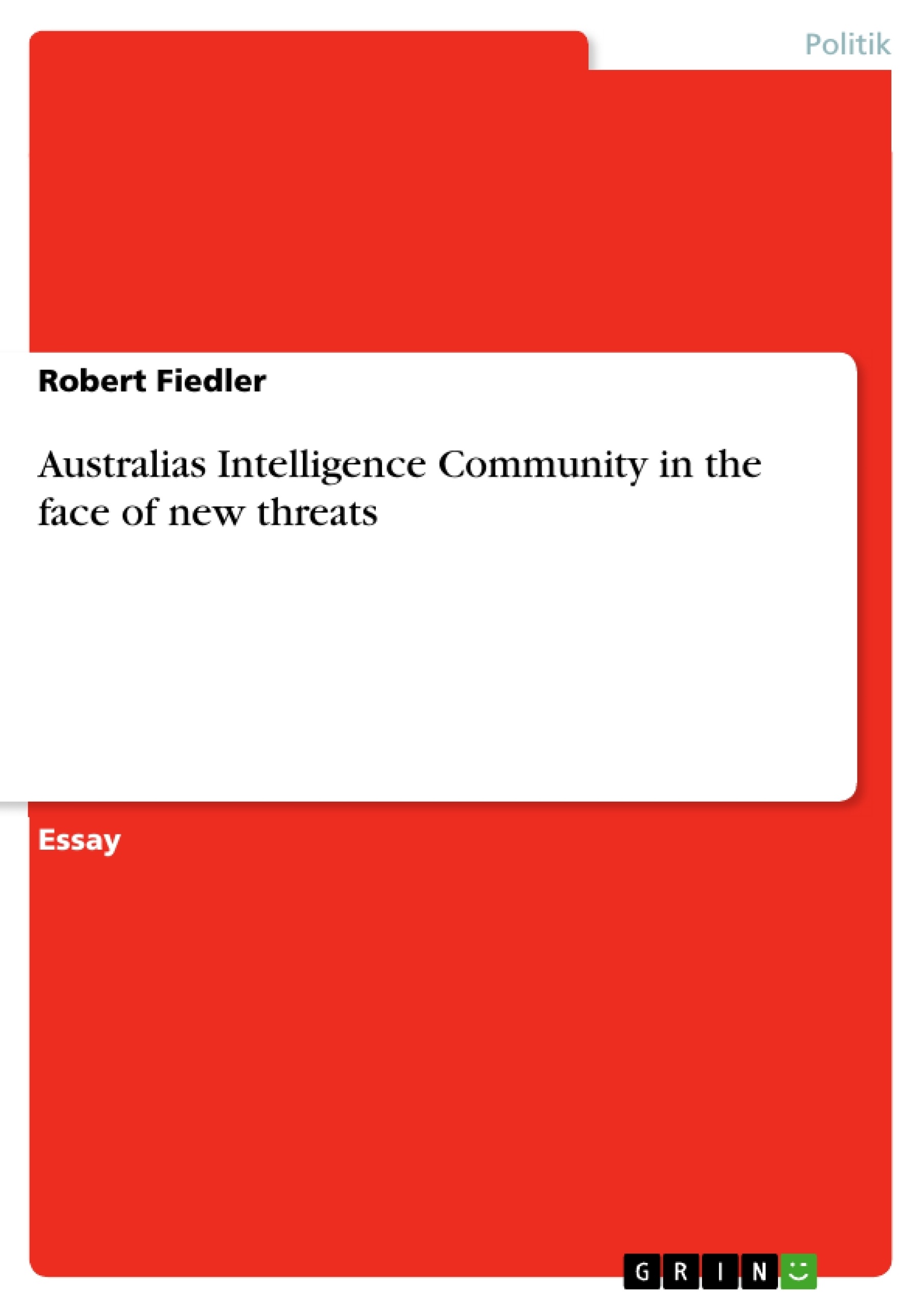Leseprobe
Australia’s Intelligence Community in the face of new threats
During the cold war Australian intelligence agencies did what intelligence agencies where expected to do, gathering information and knowledge on a defined enemy represented by states or military alliances such as the Warsaw Pact. In a post-cold war era, these conventional threats still exist, however they are overlaid by other security threats such as regional instability, the rise of international terrorism, the proliferation of weapons of mass destruction, transnational crime and non-human agency threats such as climate change. The problem with this new security agenda is the asymmetry of these new threats since the nation state Australia has to cope with groups, networks, non-state actors, or even individuals, some of them are hard to detect and even harder to combat. Therefore, strategic uncertainty has become one of the defining determinants in a new security environment. The rapid growth of human and financial resources devoted to Australian Intelligence demonstrate the relevance conceded to intelligence, now considered to be the “the most effective tool in the struggle against new security threats” (Ungerer, 2008a, p. 1). Yet, it is necessary to analyze if Australia’s intelligence community (AIC) measure up to the high expectations and challenges posed by the new security agenda. This paper will provide an assessment of AIC’s efforts to combat asymmetric threats by analyzing the performance of intelligence agencies in the face of selected asymmetric threats. Based on the results of this assessment, steps towards a more effective intelligence answer to non-conventional security threats will be proposed.
The advent of new security threats since the Berlin Wall came down clearly influenced the development of Australia’s national intelligence agencies. However, it required the catastrophic terrorist attacks of 9/11 and the Bali bombings in 2002 to advance the adaptation of AIC to a changed security agenda. In the years after 9/11 governments spending on intelligence rocketed from 332 million dollars in 2000-01 to 659 million dollars in 2004-05. In addition, the number of personnel in the AIC increased by 47 % in the same period (Flood, 2004, p. 16). However, the organizational structure, established in the cold war era still dominate the AIC today as the intelligence community is still divided in a collection branch consisting of the Australian Secret Intelligence Service (ASIS), the Defence Signals Directorate (DSD), and the Defence Imagery and Geospatial Organisation (DIGO) and an assessment branch consisting of the Office of National Assessment (ONA), and the Defence Intelligence Organisation (DIO). Therefore, the Australian intelligence agencies have “either a covert collection or an assessment role, but not both” (Office of National Assessment, 2006, p. 4). An unique exception is the Australian Security Intelligence Organisation (ASIO) which has both, collective and assessment tasks, a fact that emanates from its focus on security intelligence and “therefore has a particular, but not exclusive domestic focus” (Office of National Assessment, 2006, p. 4). The performance of Australia’s intelligence community to combat asymmetric threats is unequal. The 2003 Defence Update leaves no question that terrorism is the key security challenge for Australia by stating that “it [terrorism] may eventually be seen as the most violent phenomenon of the information age […] the reality is that terrorism has gained strategic advantages by turning the strength of tolerant and open societies into weaknesses and then striking at vulnerable points to devastating effects. For Australia this reality was brought home in Bali” (Department of Defence, 2003, pp. 11–12). Consequently, “timely and effective intelligence is the best weapon against the terrorist threat to Australia” (Howard, 2004). Therefore, it is not surprisingly that the funding for intelligence rocketed to 1.3 billion dollars each year and particular attentions has been devoted to the research and analyst capacities on terrorism in order to “improve domestic counter terrorism” (Ungerer, 2008a, p. 3). It is estimated that counter-terrorism claims more than 70 % of the current collection work in the three defence intelligence agencies (Ungerer, 2008a, p. 3). Within the fight against terrorism, ASIO takes an important role as “ASIO remains the agency in the AIC responsible for preparing and distributing threat assessments and specific warnings regarding terrorism” (O'Neil, 2007, p. 479). Furthermore, ASIO takes a strengthened role in the internal security, especially with the Australian Federal Police (AFP), hence “both the AFP and ASIO characterise their relationship as never closer” (Flood, 2004, p. 75). In addition, the Joint Counter Terrorism Intelligence Coordination Unit was established as a special branch of ASIO consolidating the Australian Intelligence agencies ASIO, ASIS, DIO, DSD, DIGO, and the AFP. The Unit coordinates the effective sharing of intelligence information across the participating agencies by providing access to all relevant databases and information sources (Grono, 2004).
[...]
- Arbeit zitieren
- MSc. M.A. Robert Fiedler (Autor:in), 2008, Australias Intelligence Community in the face of new threats, München, GRIN Verlag, https://www.grin.com/document/163698
Kostenlos Autor werden






















Kommentare